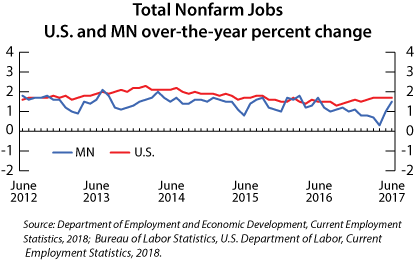by Nick Dobbins
July 2018
Monthly analysis is based on unadjusted employment data.
Employment in the Minneapolis-St. Paul MSA was up by 25,583 (1.3 percent) in June. That marked two straight months of greater than 1 percent over-the-month growth, outpacing recent years after April’s weaker-than-usual growth. Leisure and Hospitality added 10,507 jobs (5.4 percent) with Arts, Entertainment, and Recreation adding 3,441 (8.7 percent) and Accommodation and Food Services adding 7,066 (4.5 percent). Mining, Logging, and Construction employment grew by 5,348 (6.3 percent). Specialty Trade Contractors added 2,849 jobs (5 percent) while employment in Construction of Buildings was up by 851 (4.9 percent). Over the year the metro area added 40,170 jobs (2 percent). It was the first time that over-the-year growth hit 2 percent or higher since June of 2017. Among the notable gains, Leisure and Hospitality added 9,467 jobs (4.8 percent), Trade, Transportation, and Utilities added 8,131 (2.2 percent), and Manufacturing added 6,449 (3.3 percent). The Manufacturing growth was split among component sectors, with Durable Goods Manufacturers adding 4,056 jobs (3 percent) and Non-Durable Goods Manufacturers adding 2,393 (3.8 percent) despite a loss of 374 (2.5 percent) in Printing and Related Support Activities, one of only two published component sectors for the industry group.
The Duluth-Superior MSA added 515 jobs (0.4 percent) in June. The gains came in spite of a decline of 1,559 (5.6 percent) in Government, driven by a drop of 1,242 (15.4 percent) in State Government, likely caused by summer school closings. Leisure and Hospitality and Mining, Logging, and Construction led the growth (up 792 or 5.3 percent and 669 or 7.3 percent, respectively). Also of note, Other Services added 345 jobs (5.2 percent), bucking the statewide trend of flat employment growth from the supersector. Annually the Duluth MSA added 2,046 jobs (1.5 percent). Mining, Logging, and Construction added 429 jobs (4.6 percent). Government employers added 799 jobs (3.1 percent), Manufacturing added 203 (2.7 percent), and Other Services added 261 (3.9 percent). The largest proportional decline came in the Information supersector, which lost 5.5 percent (77 jobs).
The Rochester MSA added 3,393 jobs or 2.8 percent in June. It was the single largest proportional over-the-month growth in any MSA in the state. Besides the usual suspects for this time of year, Professional and Business Services added 529 jobs (9.8 percent), and Education and Health Services added 585 (1.2 percent). Both of those supersectors dramatically outperformed statewide employment growth. The only supersector to lose jobs was the small Financial Activities (down 3 jobs, 0.1 percent). Annually the Rochester area added 295 jobs (0.2 percent). This was the weakest over-the-year growth of any metro area in the state. Educational and Health Services, a pillar of the Rochester labor market, lost 942 jobs (1.9 percent) on the year. While this over-the-year loss is lower than in previous months, growth in the supersector has remained in the negative for every month in 2018. The strongest annual performance in the area came from Leisure and Hospitality, which added 812 jobs (7.2 percent). Professional and Business Services added 266 (4.7 percent).
Employment in the Saint Cloud MSA was down by 364 (0.3 percent) in June. It was one of only two MSAs to lose jobs on the month. Government employers dropped 910 jobs (5.8 percent) thanks to a decline of 1,029 (25.3 percent) in State Government. The largest increases, both proportionally and in real jobs, came in Mining, Logging, and Construction, which was up by 579 (8.2 percent). Over the year the Saint Cloud MSA added 1,718 jobs (1.6 percent), just outpacing statewide employment growth. Manufacturers added 751 jobs (4.9 percent), and Educational and Health Services added 996 (4.7 percent). Trade, Transportation, and Utilities employment dropped by 277 (1.2 percent) on the year.
The Mankato-North Mankato MSA added 395 jobs (0.7 percent) in June. Counter to the statewide trend, the area’s growth came entirely in the public sector, which added 413 jobs (4.3 percent) while Minnesota employment in the supersector declined by 1.6 percent. Goods producers also added jobs, up 233 (2.2 percent) while private service providers lost 251 jobs (0.6 percent). Annually the area added 2,535 jobs or 4.5 percent. This was once again the strongest proportional over-the-year growth of any MSA in the state. Both public and private sector employment were up in the area, adding 1601 jobs (3.4 percent) and 934 jobs (10.2 percent), respectively.
Employment in the Fargo-Moorhead MSA was down by 691 (0.5 percent) in June. It was the weakest over-the-month job performance of any MSA in the state and one of only two MSAs to lose jobs on the month. Government employers shed 1,462 jobs (7.3 percent), leading the decline. Annually the area added 885 jobs (0.6 percent). Educational and Health Services added 1,077 jobs (4.6 percent), the largest real and proportional increase of any supersector. The steepest decline came in Leisure and Hospitality, which was off by 325 (2.3 percent).
The Grand Forks-East Grand Forks MSA added 53 jobs (0.1 percent) in June. Mining, Logging, and Construction added 314 jobs (10.3 percent), and Leisure and Hospitality added 411 (6.9 percent). Annually the MSA added 618 jobs (1.1 percent). Manufacturing added 205 jobs (4.8 percent), Leisure and Hospitality added 338 (5.6 percent), and Professional and Business Services added 157 (4.9 percent).
